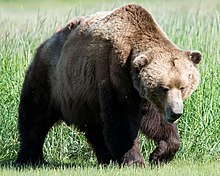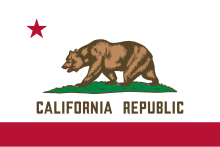| Revision as of 16:35, 10 March 2015 editWCCasey (talk | contribs)Extended confirmed users5,209 edits →Extinction: expand, add links← Previous edit | Revision as of 17:12, 10 March 2015 edit undoWCCasey (talk | contribs)Extended confirmed users5,209 edits →History and Extinction: add linkNext edit → | ||
| Line 46: | Line 46: | ||
| ==History and Extinction== | ==History and Extinction== | ||
| ] | ] | ||
| The first recorded encounters of California grizzlies by Europeans are in the diaries kept by several members of the 1769 ], first exploration by land of what is now the state of California. Several place names that include the Spanish word for bear (''oso'') trace their origins back to that first expedition. | The first recorded encounters of California grizzlies by Europeans are in the diaries kept by several members of the 1769 ], first exploration by land of what is now the state of California. Several place names that include the Spanish word for bear (''oso'') trace their origins back to that first expedition (e.g. ]). | ||
| As the settled frontier of ] was extended northward, settlers began to populate California and establish large cattle herds as the main industry. The grizzly bears killed livestock and so became enemies of the ]. '']s'' hunted the grizzlies, sometimes roping and capturing them to be displayed in public battles with bulls.<ref>{{cite book|last1=Storer & Tevis|title=California Grizzly|date=1955|publisher=UC Press}}</ref> This popular spectator sport inspired betting as to whether the bear or the bull would win. | As the settled frontier of ] was extended northward, settlers began to populate California and establish large cattle herds as the main industry. The grizzly bears killed livestock and so became enemies of the ]. '']s'' hunted the grizzlies, sometimes roping and capturing them to be displayed in public battles with bulls.<ref>{{cite book|last1=Storer & Tevis|title=California Grizzly|date=1955|publisher=UC Press}}</ref> This popular spectator sport inspired betting as to whether the bear or the bull would win. | ||
Revision as of 17:12, 10 March 2015
For the University of California, Berkeley mascot, see California Golden Bears.
| California grizzly bear | |
|---|---|

| |
| Monarch, a preserved specimen. | |
| Conservation status | |
 Extinct (1922) (IUCN 3.1) | |
| Scientific classification | |
| Kingdom: | Animalia |
| Phylum: | Chordata |
| Class: | Mammalia |
| Order: | Carnivora |
| Family: | Ursidae |
| Genus: | Ursus |
| Species: | U. arctos |
| Subspecies: | U. arctos californicus |
| Trinomial name | |
| Ursus arctos californicus Merriam 1896, pp. 76–77 | |
| Synonyms | |
| |
The California grizzly (Ursus arctos californicus) is an extinct subspecies of the grizzly, the very large North American brown bear. "Grizzly" refers to the golden and grey tips of its hair. Genetically, North American grizzlies are closely related; in size and coloring, the California grizzly was much like the grizzly of the southern coast of Alaska. In California, it was particularly admired for its beauty, size, and strength. Many accounts from pioneers describe grizzlies in long, bloody fights with angry longhorn bulls, and often winning. The grizzly became a symbol of the Bear Republic, the name that California had when it was an independent nation. Later this national flag became the state flag, and then California was known as the "Bear State."
In 1866, a grizzly weighing 2,200 pounds (1,000 kg) was killed in Valley Center, California, the biggest bear ever found in California, unsurpassed until John Lang shot the world's biggest bear — 2,320 pounds (1,050 kg) — near his ranch by Canyon Country, in 1873.
California still has habitat for about 500 grizzlies, and if the North Cascade population recovers and expands, eventually the grizzly will likely return to California. There are however only about 20 of these bears remaining in that ecosystem. In 2014 the US Fish and Wildlife Service received a petition to reintroduce the California grizzly. This reintroduction would be from its very closely related Rocky Mountain grizzly.
Nomenclature

Historically, all North American grizzlies were grouped together as one unique species until DNA testing revealed that they should properly be grouped taxonomically in the same species as the smaller, European brown bears. Thereafter, Californian grizzlies were re-classified in their own subspecies alongside the brown bear. Properly, all subspecies in North America are known as Grizzlies and until recently, the California Grizzly was classified Ursus horribilis.
Symbolism

Before joining the United States California was known as the Bear Republic owing to extensive numbers of the world's largest bears, the blond and powerful California grizzlies, ranging throughout. Later, the nickname "Golden State" was added noting the region's 1848 gold rush discovery and its native golden poppy flora.
The California grizzly is one of the state’s most visible and enduring symbols, adorning both the state flag and seal. The Bear Flag first flew in 1846 as a symbol of the short-lived California Republic, but was replaced by a second version adopted by the State Legislature in 1911. The bear symbol became a permanent part of the State Seal in 1849. The California Grizzly was designated the official State Animal in 1953. The bear is celebrated in name and as mascot of the sports teams of the University of California, Berkeley (the California Golden Bears), and of the University of California, Los Angeles (the UCLA Bruins) and in the mascot of University of California, Riverside (Scottie the Bear, dressed in a Highland kilt). The California Maritime Academy operates a training ship named "Golden Bear".
History and Extinction

The first recorded encounters of California grizzlies by Europeans are in the diaries kept by several members of the 1769 Portola expedition, first exploration by land of what is now the state of California. Several place names that include the Spanish word for bear (oso) trace their origins back to that first expedition (e.g. Los Osos).
As the settled frontier of New Spain was extended northward, settlers began to populate California and establish large cattle herds as the main industry. The grizzly bears killed livestock and so became enemies of the rancheros. Vaqueros hunted the grizzlies, sometimes roping and capturing them to be displayed in public battles with bulls. This popular spectator sport inspired betting as to whether the bear or the bull would win.
One popular, though false account is that Horace Greeley, after seeing such a fight, gave the modern stock market its "bear" and "bull" nicknames — based on the fighting styles of the two animals: the bear swipes downward while the bull hooks upward. Less than 75 years after the discovery of gold in 1848, every grizzly bear in California had been tracked down and killed. The last hunted California grizzly was shot in Tulare County, California in August 1922. Later, in 1924, a grizzly known to roam an area of the Sierra Madre Mountains (Santa Barbara County) was spotted for the last time, and thereafter, grizzlies were never seen again in California.
References
- ^ "Valley Center History Museum". Retrieved 2012-05-05.
- "Santa Clarita Signal". Retrieved 2013-08-02.
- Carroll, C., R. F. Noss, N. H. Schumaker and P. C. Paquet (2001). David Maehr, Reed F. Noss, Jeffery L. Larkin (ed.). Large Mammal Restoration: Ecological and Sociological Challenges in the 21st Century (1 ed.). Washington, DC: Island Press. pp. 25–46. ISBN 9781559638173.
Is the return of the wolf, wolverine, and grizzly bear to Oregon and California biologically feasible?
{{cite book}}: CS1 maint: multiple names: authors list (link) - Morgan, Chris P.; Davis, James; Ford, Tim; Laney, Nan (2004). "Promoting understanding: The approach of the North Cascades Grizzly Bear Outreach Project" (Ursus 15(1) Workshop Supplement:137-141).
- Miller, C., Waits, L. & Joyce, P. (2006). "Phylogeography and mitochondrial diversity of extirpated brown bear (Ursus arctos) populations in the contiguous United States and Mexico". 15 (14): 4477–85.
{{cite journal}}: Cite journal requires|journal=(help)CS1 maint: multiple names: authors list (link) - "History and Culture - State Symbols" (State Nickname). California State Library. State of California. 2014. Retrieved 7 May 2014.
...can be traced back to the discovery of gold in 1848 and fields of golden poppies...
- Trinkle, William J. (4 August 2013). "A Brief History of the Bear Flag". The Bear Flag Museum. Sacramento, CA USA. Retrieved 7 May 2014.
The flag soon came to be called the "Bear Flag" and the insurgency came to be called the "Bear Flag Revolt"
- "History and Culture - State Symbols". California State Library. Retrieved 23 September 2011.
- California State Legislature (1911), "An act to select and adopt the bear flag as the state flag of California", The statutes of California and amendments to the codes passed at the thirty-ninth session of the legislature, San Francisco: Bancroft-Whitney, p. 6, retrieved 24 September 2011
- Storer & Tevis (1955). California Grizzly. UC Press.
- "Bull, n1 III.8.a." OED Online. Oxford University Press, December 2014. Web. 20 January 2015.
- Johnson, Brett (August 9, 2014) "Great grizzly bear hunt in Santa Paula backcountry reaps state flag icon, tall tales" Ventura County Star
Further reading
- Merriam, C. Hart (13 April 1896), "Preliminary Synopsis of the American Bears", Proceedings of the Biological Society of Washington, 10: 65–83 + plates IV–VI, retrieved 23 September 2011
- Wozencraft, W. C. (2005). "Subspecies Ursus arctos californicus". In Wilson, D. E.; Reeder, D. M. (eds.). Mammal Species of the World: A Taxonomic and Geographic Reference (3rd ed.). Johns Hopkins University Press. p. 589. ISBN 978-0-8018-8221-0. OCLC 62265494.
- Merriam, C. Hart (13 August 1914), "Description of Thirty apparently New Grizzly and Brown Bears from North America", Proceedings of the Biological Society of Washington, 27: 173–196, retrieved 24 September 2011
- Merriam, C. Hart (6 September 1916), "Nineteen Apparently New Grizzly and Brown Bears from Western America", Proceedings of the Biological Society of Washington, 29: 133–154, retrieved 24 September 2011
- Hall, E. Raymond (10 August 1984), "Geographic variation among brown and grizzly bears (Ursus arctos) in North America", Special publication 13, University of Kansas Museum of Natural History, retrieved 24 September 2011
- Miller, Craig R.; Waits, Lisette P.; Joyce, Paul (December 2006), "Phylogeography and mitochondrial diversity of extirpated brown bear (Ursus arctos) populations in the contiguous United States and Mexico" (PDF), Molecular Ecology, 15 (14): 4477–4485, doi:10.1111/j.1365-294X.2006.03097.x, PMID 17107477, retrieved 24 September 2011
- Solnit, Rebecca; Caron, Mona (2010), A California Bestiary, Berkeley, CA: Heyday Books, pp. 13–15, ISBN 978-1-59714-125-3
External links
- "Ursus arctos californicus". Integrated Taxonomic Information System.
- "Ursus arctos californicus Merriam, 1896". The Encyclopedia of Life.
- Shaggy God - Topic: Ursus arctos californicus Merriam, 1896
- The Monarch Bear Institute
- Bring Back the California Grizzly
- Grizzly Bear National Monument (proposed)
![]() Data related to Ursus arctos californicus at Wikispecies
Data related to Ursus arctos californicus at Wikispecies